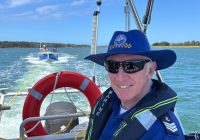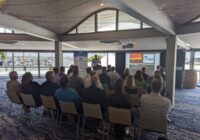News from the office of Marine Safety South Australia
Coastal waters busy in January
Visitors surged to the coastal waters during the January school holidays and Australia Day long weekend. Our Marine Safety Officers were out at boat ramps and on water, ensuring vessel operators were equipped with all the safety equipment they needed including lifejackets, and were registered and licensed. On water patrols were focused on unsafe behaviours including speeding.
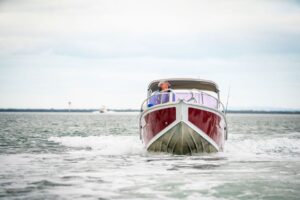
Over the January period, 35% of vessels checked were non-compliant. The main offences recorded during January were:
- failure to wear a lifejacket
- carrying expired flares
- speeding – particularly personal watercraft (jet skis) exceeding 4 knots within 200 metres of the metropolitan coastline (between Outer Harbor southern breakwater and the southern end of Sellicks Beach).
Marine Safety Officers have an education role as well as compliance and were educating the public about the importance of wearing a properly fitted lifejacket. Lifejackets are rated either Level 150, Level 100, Level 50, or Level 50S, based on how much buoyancy they provide. You can find which lifejacket is right for where you are operating via the online lifejacket checking tool. Of the vessels checked 96% had lifejackets on board that were meeting the current Australian Standard (AS) 4758. People wearing lifejackets under older standards have until 1 January 2025 to update to the current standard.
Recreational boating restrictions eased on River Murray
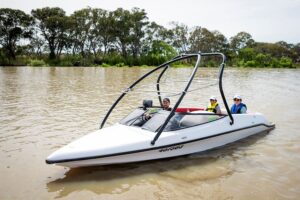
As the River Murray flood waters recede the restrictions on recreational boating that were in place have been easing regularly as it becomes safe to operate vessels along the river. Check all the current restrictions and what is allowed depending on where you are operating here.
Please remember in all zones, a person must not:
- Enter or remain on an engaged levee except for an emergency, inspection, maintenance, or repair.
- Moor, anchor, attach, or secure your vessel to an engaged levee.
- Operate a vessel, exceeding a speed of 4 knots within 250 metres of an engaged levee or within 250 metres of any dwelling or buildings, where any part of the dwelling or building is partially or wholly submerged.
If returning to river activities like boating and water skiing, please take appropriate precautions and check for hazards which may not be clearly visible, such as submerged logs.
Marine Safety working in flood recovery
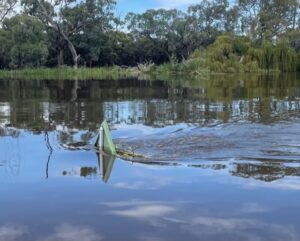
Navigational markers that went underwater during the floods are being checked for damage and replacement.
As the flood waters on the River Murray subside, property and business owners are starting the long hard clean-up. The Marine Safety team from the Department for Infrastructure and Transport have a key role to play in inspecting and checking marine safety signs along the river including km markers, directional signs, ferry signs, navigational buoys and navigational beacons while also assisting in removing navigational hazards.
The public can help by submitting a marine safety concern form if they spot a hazard on the water. With the river opening up to recreational boating, the team is working hard to make sure all marine safety signage and aids to navigation are in place. Operators are reminded to take due care as there is still a lot of debris along the river.
Stay safe on the water near big ships
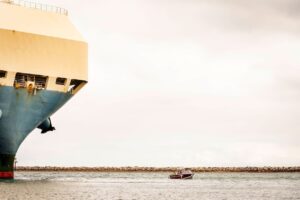
With the weather perfect for our recreational boaties, Flinders Port Holdings would like to remind everyone to be safe on the water.
With some near misses within channels in our regional ports, we’re wanting to ensure everyone remains safe while enjoying their time on the water.
Recent incidents have included recreational boats anchoring in and blocking channels and boats passing too fast and close to the sides of vessels.
Here are some tips to help you stay safe on the water around Port Adelaide and South Australian Regional Ports.
Be Responsible – Be aware of your responsibilities
Be Aware – Know who is about
Be Seen – Never anchor in a shipping channel
Stay Safe – Never assume you have been seen
Remember:
- The speeds of large vessels can be deceptive and may be hard to judge. It can take big ships up to two kilometres to stop.
- Large ships can’t see you. Their ‘blind spot’ can extend for many hundreds of metres, even up to one kilometre, in front of them.
- Large vessels must keep up speed in order to steer and they need to stay in the channel. Sometimes the channel extends bank-to-bank, so expect large vessel traffic on all parts of the waterway, such as Outer Harbour and upper sections of the Port River.
- It is dangerous and difficult for large vessels to change course. They must line up and commit to their course well ahead, around bridges, bends in the channel and when leaving and approaching their berth. Stay out of their way.
For more information about safety on the water including restrictions around anchoring in channels and safety near commercial vessels, click here.
Flinders Port Holdings have a safe on the water fact sheet available here.
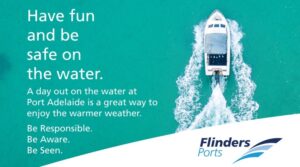
Let someone know before you go
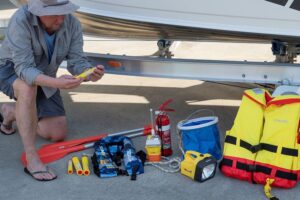
Many anglers and recreational boaters are taking the opportunity to enjoy the warm February weather in the evening to fish, crab, or take a sunset cruise. No matter what time you are heading out on your vessel, it is vital to let someone know where you are going and what time you plan to be back. They can help alert authorities if you don’t return.
The Deckee app which is free to download, allows you to log your trip with friends and family really easily and is another option to help let people know your trip details.
Before you go out, remember to follow these tips to stay safe on the water:
- Always check the weather report and ensure your boat is suited to the conditions and where you are operating.
- Do you have enough fuel? Plan for 1/3 out, 1/3 back and 1/3 reserve.
- Fully charge your boat and mobile phone batteries.
- Make sure you have all your safety gear on board, including distress signals that will help you notify someone if things go wrong, including:
- Flares – are compulsory when operating on semi protected waters and beyond. You need 2 red and 2 orange flares (make sure they haven’t expired) and know how to use them. Watch this video for tips.
- EPIRB – is compulsory if you are planning to travel more than 3 nautical miles from shore on unprotected waters and 5 nautical miles from shore in gulf waters. They are a great idea for every vessel to have on board, even if you aren’t travelling that far out. Register your EPIRB with AMSA. Registered EPIRBs allow AMSA Search and Rescue to phone your emergency contacts and look up important information to initiate a response as soon as possible. An unregistered beacon can cause a delay in response. Watch this video for tips on using an EPIRB.
- If you have a marine radio, check-in with volunteer marine rescue before heading out (see the marine radio story in this edition for more information about using a marine radio). Remember if you are travelling more than 2 nautical miles from shore you are required to have a marine radio on board. Mobile phones are useful but are not a substitute for marine radio and may not provide service away from shore.
Marine radio – ‘000’ of the water
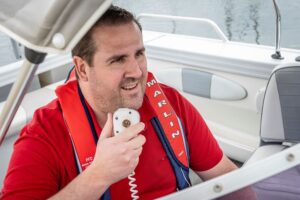
The possibility that a marine radio may save your life is the best reason to install one in your boat and learn how to operate it. You can use your marine radio to:
- Monitor distress frequencies.
- Contact other vessels if you need help.
- Contact shore-based stations that can co-ordinate a rescue.
- Keep you up-to-date with weather information and navigational safety warnings.
Marine radios are required on vessels if you are operating in unprotected waters more than 2 nautical miles from the coastline but can also be used closer to shore.
There are two types of marine radio that recreational boaters generally use:
27 MHz marine radio
- Popular for use on recreational boats and provide short-range communications.
- Do not provide the range or performance of a VHF radio.
- Suitable for operating in protected and semi-protected waters or in unprotected waters within the range of a coast station.
- 27 MHz marine may be monitored by other recreational vessels or at various locations and hours of operation by Volunteer Marine Rescue radio bases.
- 27 MHz marine radios do not need to be licensed and no operator’s licence is required to use one.
VHF marine
- VHF marine transceivers provide better short-range communications than a 27 MHz radio.
- Suitable for operating in protected and semi-protected waters or in unprotected waters within the range of a coast station or a VHF marine repeater station.
- An operator’s licence is required to use a VHF marine radio but no licence is needed to have one fitted on your boat.
Marine radio training courses
A range of marine radio courses are available online and face to face for the marine radio licence you require. The two most common courses suitable for recreational boaters are the Australian Water Qualification (AWQ) for those operating within 12 nautical miles of the coast) or the Short Range Operator Certificate of Proficiency (SROCP). The South Australian Sea Rescue Squadron hold training courses in SROCP or you can search online to find other available courses.
Voyage reporting
If you have a marine radio, it is important to log your trip on and off with your local coastal volunteer marine rescue station. Below are some tips from volunteer marine rescue on what you need to do to report your voyage:
Logging on – Contact the relevant coastal station and tell them:
- Your vessel’s call sign.
- Where you left from.
- Your destination.
- Number of people on board.
- Estimated time of return or arrival at your destination.
Logging off – Contact the relevant coastal station and tell them:
- Your vessel’s call sign.
- You have safely returned to shore or reached your destination.
Basic marine radio operating protocol includes:
- Using standard radio procedures.
- Always identifying yourself on air.
- Being familiar with your radio equipment.
- Being brief and mindful of your language.
- Listening before you talk.
- Always monitoring relevant distress frequencies 27MHz Ch 88 / VHF Ch16.
Volunteer Marine rescue (VMR) have more information below around monitoring hours, scheduled contacts – or skeds – and regular weather reports. For further information visit Volunteer Marine Rescue (VMR) coastal radio network.
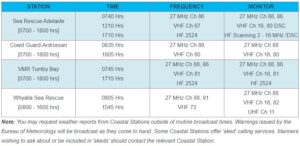
For more information visit marinesafety.sa.gov.au









